From The Technological Herbarium, by Gianna Maria Gatti: Artworks of Nicola Toffolini
Nicola Toffolini’s Naturale che piove: fare il bello ed il cattivo tempo (It’s Raining, Naturally: Making Good and Bad Weather)
translated from the Italian by Alan N. Shapiro
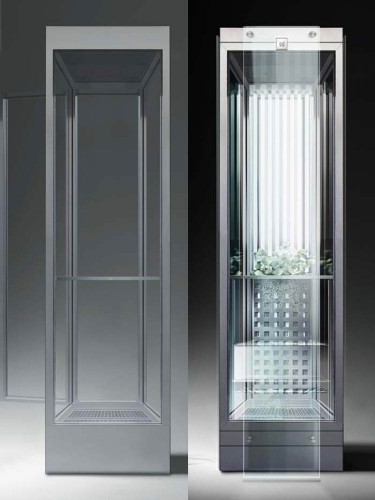
autore: Nicola Toffolini titolo: Naturale che piove: fare il bello ed il cattivo tempo data di realizzazione: 2002 dimensioni: Altezza 240,0 cm; Larghezza 80,0 cm; Profondità 75,0 cm
Nicola Toffolini works on the nature-technology marriage by elaborating singular ecosystems enclosed in glass and aluminium cases of marked formal elegance. Inside plants have been placed which, in order to live, depend on sophisticated electronic mechanisms, which visitors operate from the outside interactively.
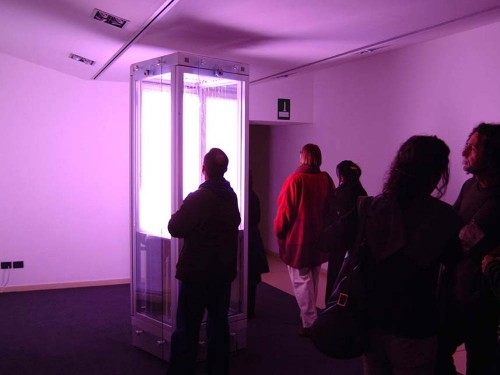
autore: Nicola Toffolini titolo: Naturale che piove: fare il bello ed il cattivo tempo data di realizzazione: 2002 dimensioni: Altezza 240,0 cm; Larghezza 80,0 cm; Profondità 75,0 cm
In Naturale che piove: fare il bello ed il cattivo tempo, a hyacinth of water is subject to meteorological and climatic variations determined by the choice of the users to make night fall or the day rise, to make it rain or not inside the case, stimulated by sensors or by direct contact with the glass.
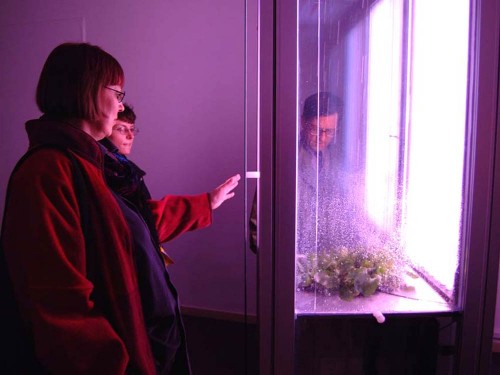
autore: Nicola Toffolini titolo: Naturale che piove: fare il bello ed il cattivo tempo data di realizzazione: 2002 dimensioni: Altezza 240,0 cm; Larghezza 80,0 cm; Profondità 75,0 cm
All the elements necessary to guarantee the life of the vegetable are contained in this micro-environment. First of all, there are a series of neon, luminous strips arranged vertically and parallel to each other which are vaguely reminiscent of solar rays and emanate a luminous flux the intensity of which varies gradually in a way that simulates the passage of the day. Through illumination, the lamps produce warmth, which causes the evaporation of the water situated at the base of the structure. Condensing in drops, the water falls again in the form of rain on the hyacinth: in this way, the mineral salts deliberately dissolved in it can reach the plant and provide it with indispensable nourishment.
The installation was realized for the national competition sponsored by Aiace-Invideo and, having been selected as the winner, was shown at the exhibition “Techne 02. Tra arte e tecnologia – Viaggio nel mondo dell’interattività” (“Between Art and Technology – Journey into the World of Interactivity”), curated by Romano Fattorossi, which took place at the Spazio Oberdan in Milan from October 2002 to February 2003.
In 2001, Toffolini had already exhibited, at the Galleria Otto in Bologna, Un metro quadro di chiassose cicale nella sezione verticale di un campo di grano (“A Square Meter of Noisy Cicadas in the Vertical Section of a Wheat Field”), an analogous installation where the growth of grass inside a case proceeded thanks to a sophisticated interactive technological setup, and was accompanied by the singing of insects.
A continuous cycle revolving around the two primary factors of life, light and water, and the consequent recirculation of air and water: weather and atmospheric events have thus been artificially recreated and follow each other with rhythms that no longer respect their natural course. Dictating their appearance is the unpredictable outcome of user interaction: a disturbance that can also have repercussions on the growth of the vegetable, however in need it is of a certain regularity in external conditions for its own biological functioning.
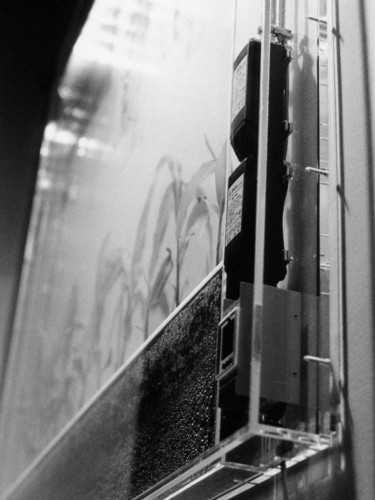
autore: Nicola Toffolini titolo: Un metro quadro di chiassose cicale nella sezione verticale di un campo di grano data di realizzazione: 1999_2002 dimensioni: Altezza 120,0 cm; Larghezza 120,0 cm; Profondità 6,0 cm.
Constrained within a case that protects it but also isolates it, the living being would seem to be reduced to the archeological find of a museum exhibit, to an object of experimentation, if Toffolini did not give voice to the process that engages it, amplifying its otherwise imperceptible sounds caused by the rainfall on the leaves: an organic musicality that is born of the contact between the drops seen by the artist ‘as percussions’ and the dense surface of the leaf, ‘small database of sounds’. Toffolini gives to the vegetable the possibility to make heard its ‘sonorous response to the water’ and to manifest its living presence within this artificial technological world: “The definitive breaking down of the internal limits of the environment,” he asserts, “is obtained in virtue of the sonorous element that has been introduced with the function of making explicit the opening beyond itself of the natural world.”93 To increase the aesthetic effect of sounds, the synthetic chirping of crickets and cicada is added to emphasize the passage of day to night. A harmony of sounds which, augmenting the perception of the visitor which is also auditory, renders more concrete the communication between his external space and the internal space where the hyacinth grows. This is the purpose of the artwork: to engage the spectators and make them participants in what happens inside the case to assure the survival of the plant. Nature is enclosed in a compact and technological structure, a reality in itself, but not in order to cut it off from man, but on the contrary, to extol how much man can have an influence on nature, for good and for bad, as the title already evokes. It is a descriptive title that suggests not only the process that is carried out in the work, but also its metaphorical assumption of universal value.
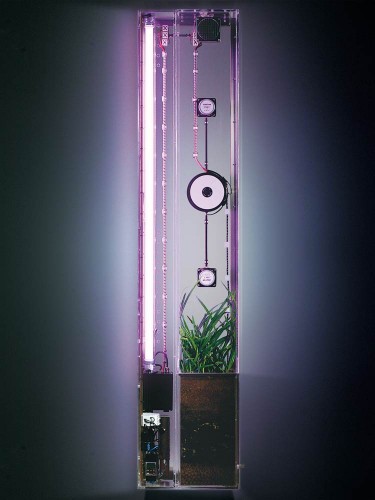
autore: Nicola Toffolini titolo: Naturalmente ciclico l’ambiente polifonico per piante claustrofobiche data di realizzazione: 2003 dimensioni: Altezza 165,0 cm; Larghezza 35,0 cm; Profondità 35,0 cm,
Note: The reduced graphic resolution in this image is intentional. (ANS)
To the originality of the formulation of the titles, characteristic of the entire production of the artist, is added another element that distinguishes his mode of operating, the exhibition next to the installation of the related designs, works on paper that, as Enrico Lain points out, “are not isolated representations, so much as projects that evolve with the artworks to which they refer. They are the first concretization of a praxis, diagrammatic representations that entirely clarify the work before its materialization.”
See E. Lain, “Centometriquadri di verde acido – sul lavoro senza nome di Nicola Toffolini” (“One Hundred Square Meters of Acid Green – on the Untitled Work of Nicola Toffolini”), presentation text of the one-person exhibition of Toffolini held at the Galleria Lipanje Puntin in Trieste from December 2004 to February 2005.
On the subject of the singular title “without proper name” of the artist’s works, Lain cites as examples: Venire alla luce e lasciarci le penne (“Come to the Light and Let Go of the Feathers”), Dove comincia il suono di un albero e finisce il rumore del vento (“Where the Sound of a Tree Begins and the Noise of the Wind Ends”), Naturalmente ciclico l’ambiente polifonico per pianteclaustrofobiche (“Naturally Cyclical the Ambience Polyphonical for Claustrophobic Plants”), Giù la testa vs Su la testa (“Head Down vs. Head Up”).
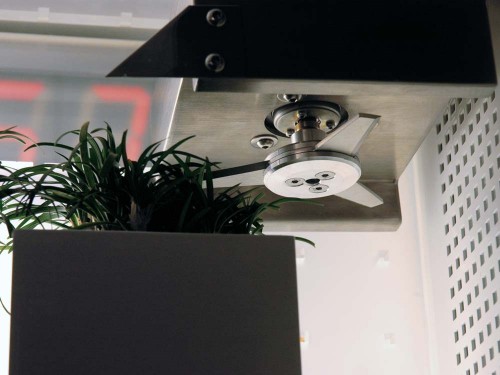
autore: Nicola Toffolini titolo: Giu’ la testa vs su la testa data di realizzazione: 2003/2004 dimensioni: Altezza 80,0 cm; Larghezza 80,0 cm; Profondità 35,0 cm,
Naturale che piove…is equipped with a figurative apparatus on paper made from designs and captions that aids in its comprehension: it is not a matter of simple project sketches but of true explanatory and detailed panels providing information on the structure of the technological equipment, on its operation in relation to the plant and the visitors, on the dynamics of the various processes. Beyond this, ample space is given to the botanical characteristics of the water hyacinth, an Eichhornia Crassipes: the richness of particular descriptions, as well as the painstaking line graphic of the images, have prompted the critic Gabriele Perretta to see analogies with the old herbaria, specifically with the Herbarum vivae icones of Otto Brunfels illustrated by Hans Weiditz, of the mid-fifteenth century, but also with the more powerful Atlantic Code of Leonardo.95 An unmistakable style which seems to inspire Toffolini right up to the choice of monochrome: a black line on pale yellow colored paper, almost to intentionally make the panel look antiquated. But beyond the aesthetic aspect, the affinity with the scientific artist of the Renaissance is evoked by the attentive research that Toffolini directs towards both natural and technological mechanisms, and, in the ensuing practical application of these mechanisms in the realization of the artwork, by the way that he makes the effort to draw on solutions from the most advanced fields, including industrial research.
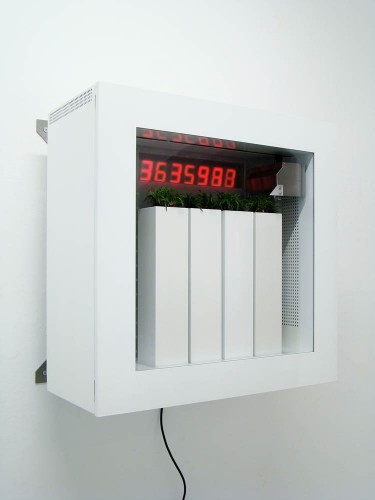
autore: Nicola Toffolini titolo: Giu’ la testa vs su la testa data di realizzazione: 2003/2004 dimensioni: Altezza 80,0 cm; Larghezza 80,0 cm; Profondità 35,0 cm,
Sabrina Zannier commented on the installation Venire alla luce e lasciarci le penne (“Come to the Light and Let Go of the Feathers“), winner in 2002 of the “Targetti Art Light Award,” and more generally on the “specific identity” of Toffolini’s work, asserting that it is “characterized precisely by a winking at the formal research of design and at the conceptual speculations of that reigning fringe of contemporary art turned towards social problems, in this case identified in the man-nature relationship behind ecological issues. Activating as a whole the increasingly necessary dialogue between culture and industry that Toffolini’s work calls for in the context of the use of technology. As the same artist underscores, in fact, a significant aspect of his participation in the Targetti competition was the precious experience born from his collaboration with the specialized technicians of the agency, exemplifying a profitable exchange of ideas and experiences among the universes of art, technology, and business.” S. Zannier, “Il premio Targetti al friulano Toffolini” (“The Targetti Award Goes to the Friulian Toffolini”), in Messaggero Veneto, March 15, 2002.
Naturale che piove: fare il bello ed il cattivo tempo
Nicola Toffolini, 2002
Naturale che piove: fare il bello ed il cattivo tempo nasce, proseguendo nella direzione che da tempo ho intrapreso, dalla commistione tra il motivo dell’interazione e la dimensione naturale. Si tratta di un progetto che costituisce un nuovo esperimento sulla via del tentativo di giocare il limite tra una dimensione supposta esterna e data, quella della natura, e una dimensione prettamente umana, quella dell’invenzione tecnologica; si tratta di un’installazione che si pone come costituzione di una natura che prende forma però proprio a partire dallo snaturamento della natura stessa.
Quello a cui ci troviamo di fronte è un ambiente sospeso definito dal volume di una teca di vetro e alluminio, in cui la natura, nella fattispecie un giacinto d’acqua (Eicchornia Crassipes) vede garantite le condizioni limite di sussistenza unicamente attraverso il funzionamento di un complesso apparato tecnico. Lo spazio della teca è infatti una cella di coltura in cui i fattori vitali per l’esistenza della pianta: illuminazione, temperatura, umidità e nutrizione, sono simulati dall’azione sinergica dei vari elementi tecnici che costituiscono l’impianto. Più dettagliatamente l’illuminazione della pianta è ottenuta per mezzo di una sorta di sole ottimizzato costituito da una serie di lampade a fluorescenza (Fluora della Osram, dimmerate), la cui emissione luminosa è centrata sullo spettro d’azione fotosintetica. La nutrizione è ottenuta invece attraverso l’adozione di una coltura di tipo aeroponico ma rovesciata rispetto alla sua forma tradizionale: il fluido nutriente infatti anziché essere nebulizzato dal basso direttamente sulle radici, è fatto qui cadere dall’alto, in forma di pioggia, per mezzo di un congegno che rinnova continuamente il ciclo vitale reimmettendo in circolo l’acqua raccolta nel serbatoio situato al di sotto della pianta.
Il proposito di artificializzare la natura non potrebbe però dirsi raggiunto col solo fatto di aver imitato altrove e con modalità extranaturali, il mondo di vita del giacinto. Con ciò infatti ci troveremmo pur sempre di fronte ad un ordine risolto in se stesso, autoreferenziale, di cui non potremmo che prendere atto a posteriori. Il gioco della mobilitazione dei confini può compiersi allora solo facendo sì che il ciclo naturale della pianta venga a dipendere dall’apporto di qualcosa di esterno alla macchina: il fruitore appunto che nell’incontro con l’installazione diventa esso stesso fattore vitale come regolatore dei ritmi con cui si produce l’intero ciclo.
Sono due le modalità in cui si dispiega l’interazione dello spettatore con l’impianto: una prima modalità, passiva, consiste nel fatto che l’avvicinamento dello spettatore, rivelato attraverso una serie di sensori di prossimità, interviene sulle condizioni meteorologiche in corso all’interno dell’ambiente, arrestando la caduta della pioggia. Una seconda modalità, questa volta attiva, consiste nella possibilità per lo spettatore, attraverso un semplice tocco della superficie vetrata, di far calare una condizione notturna in modo da interrompere l’azione di soleggiamento precedentemente in corso.
Alla luce di ciò si comprende bene dove stia il gioco sul limite naturale: l’arbitrio dello spettatore diventa essenziale nella decisione dell’andamento del corso interno di alternanza tra pioggia e sole, giorno e notte.
Lo sfondamento definitivo dei limiti interni dell’ambiente è ottenuto in virtù dell’elemento sonoro che è stato introdotto con la funzione di esplicitare l’apertura oltre se stesso del mondo naturale.
Questo intento è conseguito da un lato per mezzo dell’amplificazione del rumore, naturalmente impercettibile, prodotto dalla percussione delle gocce di pioggia sulla superficie delle foglie; dall’altro attraverso la funzione puramente estetica del canto sintetico di grilli e cicale in corrispondenza del giorno e della notte.
La peculiare modalità di interazione che si è adottata per questo progetto si caratterizza per il fatto che, laddove generalmente il rapporto interattivo tra spettatore e apparato si dispiega nella forma prefissata e monotona di una reazione della “macchina” ad un’azione dell’osservatore, qui il gioco tra i due è mantenuto aperto sulla possibilità in virtù dell’evoluzione vitale della pianta le cui possibilità di sviluppo, compreso il possibile degrado dell’organismo, riflettono le dinamiche complessive dell’interazione tra pianta, macchina e uomo.